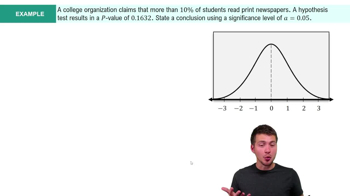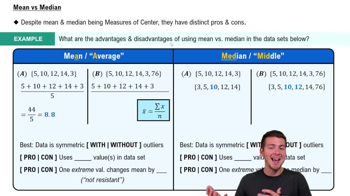Significant For 100 births, P(exactly 56 girls) and P(56 or more girls) Is 56 girls in 100 births a significantly high number of girls? Which probability is relevant to answering that question?
Table of contents
- 1. Intro to Stats and Collecting Data1h 14m
- 2. Describing Data with Tables and Graphs1h 55m
- 3. Describing Data Numerically2h 5m
- 4. Probability2h 16m
- 5. Binomial Distribution & Discrete Random Variables3h 6m
- 6. Normal Distribution and Continuous Random Variables2h 11m
- 7. Sampling Distributions & Confidence Intervals: Mean3h 23m
- Sampling Distribution of the Sample Mean and Central Limit Theorem19m
- Distribution of Sample Mean - Excel23m
- Introduction to Confidence Intervals15m
- Confidence Intervals for Population Mean1h 18m
- Determining the Minimum Sample Size Required12m
- Finding Probabilities and T Critical Values - Excel28m
- Confidence Intervals for Population Means - Excel25m
- 8. Sampling Distributions & Confidence Intervals: Proportion1h 25m
- 9. Hypothesis Testing for One Sample3h 29m
- 10. Hypothesis Testing for Two Samples4h 50m
- Two Proportions1h 13m
- Two Proportions Hypothesis Test - Excel28m
- Two Means - Unknown, Unequal Variance1h 3m
- Two Means - Unknown Variances Hypothesis Test - Excel12m
- Two Means - Unknown, Equal Variance15m
- Two Means - Unknown, Equal Variances Hypothesis Test - Excel9m
- Two Means - Known Variance12m
- Two Means - Sigma Known Hypothesis Test - Excel21m
- Two Means - Matched Pairs (Dependent Samples)42m
- Matched Pairs Hypothesis Test - Excel12m
- 11. Correlation1h 6m
- 12. Regression1h 50m
- 13. Chi-Square Tests & Goodness of Fit1h 57m
- 14. ANOVA1h 57m
4. Probability
Basic Concepts of Probability
Problem 5.1.19c
Textbook Question
Using Probabilities for Significant Events
c. Which probability is relevant for determining whether 3 is a significantly high number of matches: the result from part (a) or part (b)?
 Verified step by step guidance
Verified step by step guidance1
Step 1: Understand the context of the problem. The question is asking which probability is relevant for determining whether 3 is a significantly high number of matches. This involves comparing probabilities calculated in parts (a) and (b).
Step 2: Recall the concept of 'significantly high' events in probability. A significantly high number of matches typically refers to a situation where the probability of observing that number or more is very small, often less than a threshold such as 0.05.
Step 3: Review the probabilities calculated in parts (a) and (b). Part (a) likely involves the probability of observing exactly 3 matches, while part (b) might involve the cumulative probability of observing 3 or more matches.
Step 4: Determine which probability is relevant. To assess whether 3 is significantly high, the cumulative probability from part (b) (P(X ≥ 3)) is typically used, as it considers the likelihood of observing 3 or more matches.
Step 5: Conclude that the probability from part (b) is relevant for determining whether 3 is a significantly high number of matches, as it aligns with the definition of 'significantly high' events in probability.
 Verified video answer for a similar problem:
Verified video answer for a similar problem:This video solution was recommended by our tutors as helpful for the problem above
Video duration:
5mPlay a video:
Was this helpful?
Key Concepts
Here are the essential concepts you must grasp in order to answer the question correctly.
Probability Distribution
A probability distribution describes how the probabilities are distributed over the values of a random variable. It provides a framework for understanding the likelihood of different outcomes, which is essential for determining whether a specific result, like 3 matches, is significant in the context of the overall data.
Recommended video:
Guided course

Calculating Probabilities in a Binomial Distribution
Significance Level
The significance level, often denoted as alpha (α), is a threshold used in hypothesis testing to determine whether to reject the null hypothesis. It represents the probability of making a Type I error, which occurs when a true null hypothesis is incorrectly rejected. Understanding this concept helps in assessing whether the observed number of matches is statistically significant.
Recommended video:
Guided course

Step 4: State Conclusion Example 4
Comparative Analysis
Comparative analysis involves evaluating different sets of data or results to draw conclusions about their significance. In this context, it requires comparing the probability results from parts (a) and (b) to determine which provides a more relevant basis for assessing whether 3 matches is significantly high.
Recommended video:
Guided course

Comparing Mean vs. Median

 5:37m
5:37mWatch next
Master Introduction to Probability with a bite sized video explanation from Patrick
Start learningRelated Videos
Related Practice
Textbook Question
